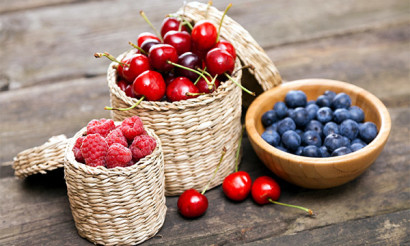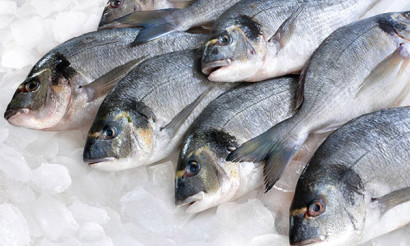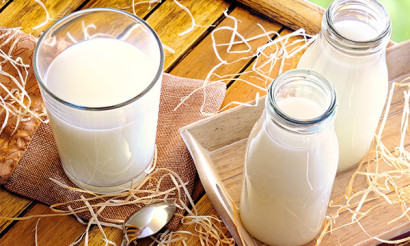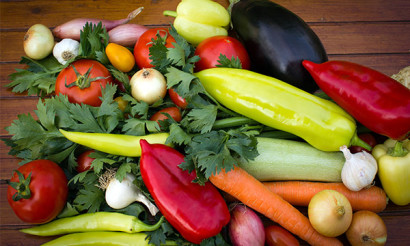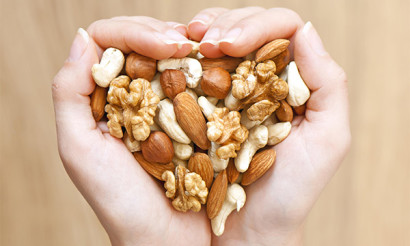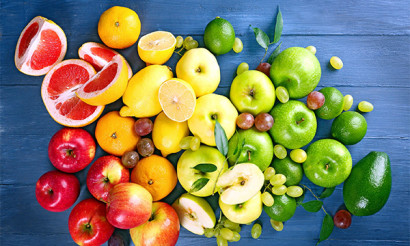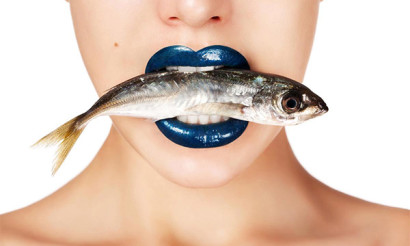How to distinguish cane sugar from a fake
In warm places where there is a humid tropical or subtropical climate, a reed called sugar cane grows. Due to temperatures above 20 degrees and moisture, abundantly watering the soil for more than six months during the rainy season, it quickly stretches out, and during dry weather, sugar is accumulated enough to become a raw material for the production of sweet products at the table of people. It is cut down and immediately sent to factories, where it is processed into an environmentally friendly, elite product. The sooner the cane goes into processing, the higher will be the quality of sugar.
What is cane sugar
Cane sugar is a sweet known since ancient times. They learned to receive it in India in the 3rd century BC. e. True, the exit from the cane of the final product at that time was small - its score went literally to grains. But time passed, the technology for the isolation of sugar improved, and they learned to cook it in such quantities that this sweet was brought even to China and the Middle East, where they started cultivating cane.
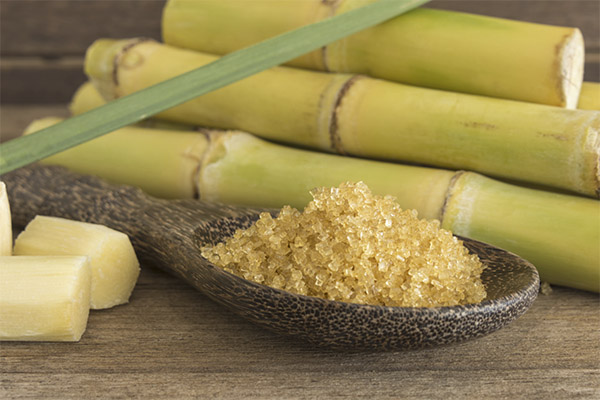
From the Arabs about the plant from which sugar is obtained, residents of the Mediterranean coast learned. Then sugar went to travel the world and even reached America.
In Russia, they first saw sugar under Peter I, in the early years of the 18th century. In those days, it was a rare and expensive product, it was even called “white gold”. Only a select few could afford to enjoy the sweetness. Cane sugar became a common product for Russians much later - centuries later.
Today it is very popular among those who are trying to lead a healthy lifestyle and eat right, as it is considered a dietary source of carbohydrates. The composition of this sugar contains a complex of useful substances, including trace elements and vitamins that have passed into it from cane. These are B vitamins, potassium and calcium, as well as copper and magnesium.
How to get
To get sugar, the cane must be cut before it has time to bloom. From the roots remaining in the ground, a new reed crop will grow. And the stems, consisting of fiber (from 8 to 12%), sugar (up to 21%), water (up to 73%), a small amount of proteins and salts, are brought to the state of a semi-finished product suitable for further processing: cut into short pieces and passed through iron shafts of huge factory juicers. Juice squeezed in this way contains about 80% water, aromatic substances. Salts and proteins are also stored.
Next, from the obtained liquid, it is required to isolate and remove proteins, for which they put fresh slaked lime or chalk in the juice and set to heat. It is brought to a temperature of 70 degrees in huge tanks called tanks. As a result, all impurities, including small pieces of reed, insects and particles of earth that got into the juice, settle to the bottom. After that, the purified liquid is filtered.
The next step is the evaporation of excess fluid. This process is not fast, as a result, a thick brownish-colored juice capable of crystallization should be obtained. Specialists call it "mother solution". It has a peculiar pleasant smell, which is especially brightly revealed in homemade pies, cakes, buns, for which hostesses love it. After evaporation, the mother solution crystallizes. As a rule, in factory conditions it is carried out alternately in three different containers.
First, the solution is heated in the first container and sugar crystals are added.It turns out a fairly light composition, which is driven in a centrifuge, where sugar is separated from molasses. It is dried using hot air, after which such a product is ready to be sent to the counter. Then they work already with molasses, starting the crystallization process in a new tank - for the second time. The result is a darker product and a rich taste.
Then the molasses goes into processing for the third time. By this time, the mother solution is already depleted, there is a minimum of sugars in it, but a maximum of the dark component. Therefore, sugar is also the darkest, but it is valued no less than the product of the first crystallization.
The process of making refined sugar is completely different. After the first crystallization, mother liquor is added to it. It turns out a mixture called magma. It is reheated with chalk or slaked lime and cleaned with an activated carbon filter. As a result, white refined sugar from cane comes out, in its qualities and appearance it is absolutely identical to that made from sugar beet.
Views
Brown cane sugar is divided into several types - depending on the location of the cane, the color and appearance of the product.
- Muscovado sugar (Muscovado sugar) is obtained from cane cultivated on the island of Mauritius near South Africa and in the countries of South America. This species has a distinct caramel flavor, its color is honey-golden, and the crystals are medium in size and slightly sticky to the touch. Oddly enough, but this sweet product is widely used for cooking not only sweet dishes - muffins, fudge, butterscotch, but also salty, can give a special taste to marinade or sauce.
- Type of sugar Demerara (Demerara sugar) was named after the river of the same name, which flows in Guyana - a small country in the north-eastern part of South America. It was from here that he began to conquer the markets of the world. The color of this sugar is golden brown, the crystals are solid, fairly sticky and brown. It is excellent in cooking - they are sprinkled with muffins, pies with fruit or berry filling, as well as fruits baked in the oven or on the grill. Food lovers believe this sugar is the perfect companion for coffee.
- Black cane sugar (Soft molasses sugar) is so called due to its dark color, it contains a significant amount of molasses. Its crystals are the softest and stickiest of all types of cane sugar. The smell and taste are very saturated, so the product has become a frequent guest on the table in Asian cuisine. But they use it not only for preparing exotic outlandish dishes, but also in simple pastries - fruit muffins, carriages.
- Turbinado (Turbinado sugar) is a sugar that has been processed not only by a centrifuge, but also by steam with water, with the help of which all contaminants and impurities are removed from the product. This is how sugar is made in Hawaii; as a result, the gamut of its colors is wide - from light honey to brown, and its crystals are large and dry, not sticky.
- Sugar Gur was born in India. This is not even sugar in the generally accepted meaning of the word, but rather a thick reed juice that can be squeezed out like a viscous condensed milk or a soft plastic sorbet.
What is the difference between brown sugar and ordinary
If we evaluate the sweetness of ordinary and cane sugar, it is easy to find out that they are no different: a couple of cubes of brown sweetener will make the tea as sweet as the same amount of white.
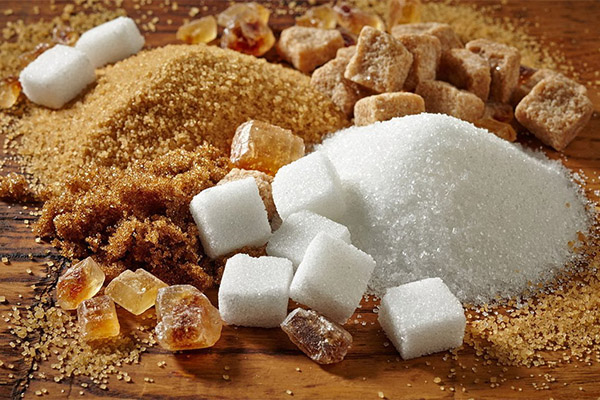
Still, cane brown sugar is different from regular sugar beet. And not only in color and appearance. It is much richer in composition, there are much more useful substances in a brown product - several dozen times.
So, potassium in brown cane sugar is 20 times more than in beet sugar, iron - 10 times.And the amount of calcium in comparison with ordinary white just rolls over - 85 times higher than in ordinary! In this case, brown sugar contains magnesium, which is absolutely absent in the beetroot product.
By the content of copper, which is involved in many processes of human life - from the synthesis of hemoglobin to the formation of collagen and stimulating the endocrine system, cane sugar can easily compete with oysters and will not yield to the marine inhabitants the palm.
Another big plus of cane sugar is the presence of B vitamins, thanks to which the body improves metabolic processes and ensures its normal functioning.
There are more nutrients in the darkest types of sugar, especially in black cane. This is because the main source of vitamins and minerals is molasses, respectively, the higher it is, the higher the value of the product.
Three times higher and its price, although much more sugar comes out from one ton of cane than from the same amount of beets. Moreover, if unrefined cane sugar is literally a culinary and dietary bestseller, then the unrefined beetroot product has a very unpresentable appearance, bad smell and an unpleasant aftertaste.
Despite the fact that per 100 g of the product brown sugar contains 98 g of carbohydrates, the body assimilates these substances slowly and for a long time, as a result the body weight is not added.
For cooks, the difference between brown and white sugar is also very noticeable. And not just because of the color. If the usual beetroot product is practically odorless, then the cane product has a light, soft and unobtrusive caramel flavor that is not lost during the cooking process. For this reason, pastries and other dishes - sauces, drinks, marinades - for the preparation of which cane sugar was used, acquire a delicate aroma. The taste of brown sugar is also slightly caramel, which also emphasizes the sophistication of the finished dish.
However, refined cane sugar is very similar to the usual, widespread white, made from beets, no different from it in properties.
Which sugar is healthier: white or brown
Considering the presence of substances necessary for the body contained in brown cane sugar, the conclusion can be made unequivocal - it is much more useful than ordinary white, regardless of whether it is made from beet or from cane.
With the same energy value, brown does not participate in the deposition of fats and does not increase weight - because its carbohydrates dissolve slowly. Moreover, these carbohydrates are a necessary element in the formation of a number of hormones involved in the vast majority of the vital processes of the body.
Due to the content of almost two hundred different components, including vitamins, minerals, salts of organic acids, the brain begins to work better. No wonder they say: before a brainstorming session, you need to drink a glass of tea with a slice of brown sugar.
Natural sweet product will help give strength and energy, calm the nerves, normalize blood pressure. These results become apparent quite quickly after consuming the product. But, in addition, in the long term, with regular use of cane sugar, the bone structure improves and the joints strengthen.
This natural product has a positive effect on a number of systems of the human body. So, digestion improves, toxins and toxins rather begin to be removed. Brown sugar boosts the functioning of the spleen and liver and stabilizes the functioning of the heart and blood vessels.
How to distinguish real cane sugar from a fake
Going to the store for brown sugar, you need to remember: the more valuable, more popular and expensive the product, the more hunters fake it.Unscrupulous producers give out ordinary canned refined beet sugar for cane, artificially introducing a simple caramel into it for color and smell. What is obtained as a result of this process is passed off as brown sugar and sold at a price higher than beet sugar and slightly lower than natural cane sugar.

Things to remember when choosing a cane product on a store shelf:
- First, a natural quality product cannot be cheap. Its minimum price is 200 rubles per kilogram. The difference in cost with regular sugar in one and a half to two times should make you think carefully and carefully examine the packaging. It should indicate that the contents from India, South America, Mauritius or from the Hawaiian Islands - only there they produce real cane sugar.
- Another prerequisite is that the packaging of a truly healthy product must bear the inscription “unrefined”.
- You also need to carefully consider the product itself. Natural cane sugar has a different crystal size, and this is clearly visible. Therefore, lump sugar cannot look like cubes of perfect size with clear even edges and ribs - they are always uneven and as if loose.
There are two other ways to identify a fake:
- If you dissolve a cube of brown sugar in a glass of water, then a fake made from beetroot and tinted with caramel will stain the liquid in a pale yellowish-brownish color. Natural reed brown water color will not change.
- It will help identify surrogate and iodine. You can drop it directly on a piece of sugar or in water, where it is dissolved. If the product is natural - in any case it will turn blue.
«Important: all information on the site is provided exclusively in fact-finding purposes. Before applying any recommendations, consult with a profile specialist. Neither the editors nor the authors are liable for any possible harm caused materials. "


